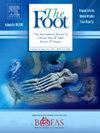跟骨ORIF术后5年内距下融合的相关危险因素
Q2 Health Professions
引用次数: 0
摘要
背景:虽然大多数跟骨骨折采用切开复位内固定(ORIF)治疗,但当保守治疗无效时,它们最终会导致距下关节炎和需要距下融合的疼痛。了解跟骨ORIF术后距下融合(STF)的相关危险因素对于优化患者预后和治疗策略至关重要。本研究旨在全面评估这些风险因素及其与STF发病率的关系,包括患者人口统计学、医疗合并症、当日和90天报销数据。方法:对2010年1月1日至2021年10月31日期间PearlDiver Mariner 157国家索赔数据库进行回顾性分析。使用现行程序术语(CPT)和ICD程序代码对接受跟骨ORIF的患者进行了5年的STF率和报销数据查询。记录患者人口统计学和合并症,并采用多因素logistic回归来确定危险因素与STF的关系。结果:患者算法有较高比例的酗酒(21.3 % 16.2 vs %)、抑郁(58.1 % 43.1 vs %),药物滥用(29.1 % 19.7 vs %),肥胖(40.3 %和28 %),烟草使用(62.2 % 50.3 vs %),所有展出的假定值小于0.001。抑郁症患者(OR: 1.54;99 %置信区间:1.29—-1.84;P 结论:在跟骨ORIF术后5年内最终需要STF的患者有更高的酗酒、吸烟、吸毒、肥胖和抑郁率。有STF和没有STF的患者在平均当天和90天的报销以及人口统计数据方面没有显著差异。本文章由计算机程序翻译,如有差异,请以英文原文为准。
Risk factors associated with subtalar fusion within 5 years following calcaneal ORIF
Background
Although most calcaneal fractures are managed with open reduction internal fixation (ORIF), they can ultimately lead to subtalar arthritis and pain requiring subtalar fusion when conservative treatments prove ineffective. Understanding the risk factors associated with subtalar fusion (STF) after calcaneal ORIF is crucial for optimizing patient outcomes and treatment strategies. This study aimed to comprehensively evaluate these risk factors and their association with the incidence of STF, including patient demographics, medical comorbidities, same day and 90-day reimbursement data.
Methods
A retrospective analysis was performed using the PearlDiver Mariner 157 national claims database from January 1st, 2010 to October 31st, 2021. Patients who underwent calcaneal ORIF, identified using Current Procedural Terminology (CPT) and ICD Procedure Codes were queried for 5-year rates of STF and reimbursement data. Patient demographics and comorbidities were recorded, and multivariate logistic regression was employed to determine the association of risk factors with STF.
Results
Patients with STF had a higher proportion of alcohol abuse (21.3 % vs. 16.2 %), depression (58.1 % vs. 43.1 %), drug abuse (29.1 % vs. 19.7 %), obesity (40.3 % vs. 28 %) and tobacco use (62.2 % vs. 50.3 %), all exhibiting a p-value of less than 0.001. Those with depression (OR: 1.54; 99 % CI:1.29–1.84; P < 0.001) and obesity (OR:1.58; 99 % CI: 1.32–1.88; P < 0.001) as comorbidities had a higher odds ratio of association with STF following calcaneal ORIF.
Conclusion
Patients who ultimately require STF within 5 years of calcaneal ORIF had higher rates of alcohol abuse, tobacco use, drug use, obesity, and depression. There was no significant difference observed between those with and without STF in average same-day and 90-day reimbursements and demographics.
求助全文
通过发布文献求助,成功后即可免费获取论文全文。
去求助
来源期刊

Foot
Health Professions-Podiatry
CiteScore
2.00
自引率
0.00%
发文量
37
期刊介绍:
The Foot is an international peer-reviewed journal covering all aspects of scientific approaches and medical and surgical treatment of the foot. The Foot aims to provide a multidisciplinary platform for all specialties involved in treating disorders of the foot. At present it is the only journal which provides this inter-disciplinary opportunity. Primary research papers cover a wide range of disorders of the foot and their treatment, including diabetes, vascular disease, neurological, dermatological and infectious conditions, sports injuries, biomechanics, bioengineering, orthoses and prostheses.
 求助内容:
求助内容: 应助结果提醒方式:
应助结果提醒方式:


